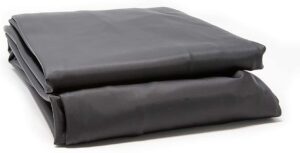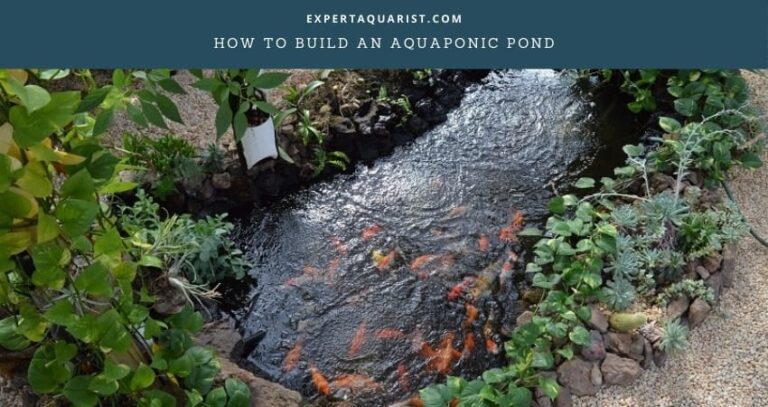Ponds are an excellent way to add life to your yard or create a garden oasis. They are also perfect for adding natural beauty and serenity.
However, finding the right liner can be challenging due to budget constraints. Pond liners are expensive because they need to withstand harsh environments like extreme weather conditions.
Some of the pond liner alternatives are polyethylene, tarpaulin, PVC liner, bentonite liner, polypropylene pond liner, lime & clay liner, and waterbed liner.
That’s why we’re going over the best alternative to pond liners that will still allow you to have a great-looking pond without breaking the bank!
Best Alternative to Pond Liners: 10 Different Materials
Adding the best pond liner inside a water feature will increase its overall durability. Apart from the conventional expensive pond liner, you have the opportunity to buy and use a cheaper pond liner for your pond. Their materials vary from each other so do their durability, flexibility, water retention ability, and anti-puncture ability too.
So let’s have a look…

1. Polyethylene Pond Liner
Polyethylene is a good alternative to traditional pond liners. Polyethylene liner can easily retain your garden pond’s water. It can also be easily shaped into whatever form your pond requires. Polyethylene has many advantages over other pond liners.
It’s strong – Polyethylene lasts for up to 20 years. It’s flexible – When building a pond you will need to excavate the area and shape it into whatever form is required.
Excavating clay or concrete means you have to break up the ground which is hard work, but with polyethylene, all you have to do is cut it to the size of your pond and it will mold itself into shape as you fill it.
It’s cheap – Polyethylene ponds are cheaper than clay or concrete ones. This is because the excavation of clay or concrete ponds can be very expensive whereas polyethylene ponds don’t require any major work.
Polyethylene ponds are not without their disadvantages. Facing extreme heat this liner can expand plus release its chemical substance into the water. And the latter one is very harmful to aquatic life in the pond.
It’s easy for plants and algae to grow on them. This means they need to be scrubbed down regularly. And it’s not possible to insulate the pond with rocks or stones. Because it is too thin compared to other liners.
HDPE is a good choice for pond liners. It is very durable and resistant to tears, abrasion, or chemicals. HDPE can be easily shaped around an area where excavation has already taken place. Chemically inert so will not pollute the water.
Additional Read: Can you use visqueen as pond liner
2. Tarpaulin Liner
A tarpaulin pond liner is made of waterproof material that holds the water within the container. This type of material is commonly used in making ponds for fish or other animals.
Tarpaulins are generally made of plastic or PVC, which is lightweight and flexible. Tarpaulin Pond Liners are easy to install too. They could be folded into a small package for easy transportation, so they can be brought outdoors. With different sizes available, they can meet the demand of many people.
Tarpaulin Pond Liners are flexible, which means you can create any shape your pond requires.
The durability of the tarp liner is not impressive at all. Tarpaulin Pond Liners are not designed to be permanent, so they must be replaced every few years.
They may provide hiding places for pests such as mosquitoes and other insects. The material can tear or break easily, especially in colder climates.
3. Waterbed Liner
A waterbed liner is made of high-density foam which can be used as a pond liner. It may sound like an expensive idea if you are living on a tight budget but it is not.
This product has many benefits, takes very little time to install, and is very cost-effective. The waterbed liner for the pond has an advantage over other pond liners because it is UV protected like EPDM rubber liners. It is also an excellent sealant.

The waterbed liner is capable to reduce heat loss in a colder climate or lowering heating costs in a warmer climate. It does not weigh much so installation is fairly simple. Being made with polyethylene foam, the pond liner is environmentally friendly and no toxic chemicals are used in manufacturing.
If you have a large pond and need a heavy-duty pond liner, this is the best choice for you. The waterbed liner can handle sharp rocks and sticks without tearing them apart, making it puncture-resistant.
Waterbed pond liner has negative sides too. Waterbed pond liner has very low durability and strength when compared to other pond liner materials.
Waterbed ponds have a very high risk of being hit or broken by an outside factor which can cause leakage or breakage of the pond.
This is because the walls of water bed ponds are made up of plastic materials. This will lead to loss of water and may harm the fishes inside.
4. PVC Liner
PVC liner is a good choice for a pond. Its advantages are many. It is very easy to cut, handle, and install. Its smooth surface makes the bottom of the pond clean.
Firm weather resistance makes it ultra-durable. Furthermore, it is impervious to many chemicals. And also resistant to ultraviolet rays. It is safe for fish, plants, and human beings. Commonly used in the construction industry, so the price is cheap.

With the plus point, PVC liner has some negative things too. Difficult to repair in winter or when frozen condition. If the bottom of the pond is not well prepared, there will be many bubbles. Because of its thickness, it puts a lot of pressure on soil, especially in spring and autumn, and it can easily cause big subsidence.
It is not very difficult to build a pond with PVC liner, but the main thing is we must take some precautions. Prepare well before construction. Build the bottom first and then install lining on it.
PVC liner is not so easy to be taken away by water, but it can easily fall down when pushed or pulled violently (e.g.: children playing on it).
5. Polypropylene Pond Liner
Polypropylene is another nice selection for your pond liner. It is slightly more expensive than Polyethylene but it’s not quite as stiff.
It will deform under the weight of rocks or plants just enough to give you that perfect texture that your plants and fish are looking for.
Just like Polyethylene, it can be welded together with standard equipment. It is stronger and durability is higher than EPDM.
The negative sides are that it is slightly more expensive than PE and has less flexibility.
6. Lime and Clay Liner
To hold your pond water a lime and clay cover performs as a very good pond liner. People who can’t afford or don’t plan to spend much usually use it as a pond liner.
Undoubtedly this pond lining system is a great alternative. The practice of using this liner is mostly on the village site that is based on agriculture. The fine particles inside the clay assist in the pond water retaining process.
This lining construction is easy. The clay layer is on the top of a quick lime coating. Both of these coatings create lime concrete that becomes hard. As a result, the percentage of water leakage is close to nil.
7. Bentonite Liner
The best quality of bentonite liner is that it can recover from any kind of punctures. Among many pond liner options, bentonite is one of the safest for water retention.
Moreover, this amazing pond liner does no harm to aquatic life. Because it is fully free of any kind of hard chemical substance.
When it comes to price, bentonite is much cheaper than other liners.
8. EPDM Pond Liner

EPDM liners are pretty flexible. The puncture-resistant is very high. It’s also UV rays resistant plus extreme cold & hot weather protected.
Because of their synthetic rubber build, they are highly resistant against any kind of microbial plus algae attack. Thus, it needs a little maintenance over time.
EPDM liners won’t release toxic chemicals in your pond or lake. So a safe and friendly pond liner for fish and other forms of life.
9. HDPE Pond Liner
To use HDPE for pond lining task is good but it has one problem and that is as it ages it might get cracked in harsh weather conditions. Especially in the harsh winter.
However, it can tackle moderate cold temperatures. Plus they are fine for your aquatic lives.
The materials of HDPE liner are rigid which makes it very tough to cut according to your desired size. Professionals are must to do the job for this cutting task and proper shaping of them with your pond.
And for that, these are appropriate for lining large size lakes or ponds.
10. Concrete Pond Liner
Choosing concrete as your pond liner would be good because its durability may cross your lifetime. Undoubtedly it is the most durable material for your pond lining.
If you have a plan to build a small pond then 1”-2” is required. In the case of a large pond minimum 4” layer is a must for a strong building.
Under any kind of climate, it will easily survive and the best is the retention ability of this liner. Even the chance of puncturing is extremely low because it has a rare chance of getting cracked.
However, you should use a water sealer on concrete to ensure the stoppage of leaking.
With all outstanding attributes, it has some negative things like the extremely high price, time taking process.
Conclusion
I have discussed multiple alternative pond liners. Each of them has some strong points and weak points. You can buy and use them according to your preference.
I hope this writing has helped you to find out the best alternative to pond liners.






